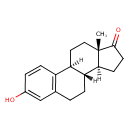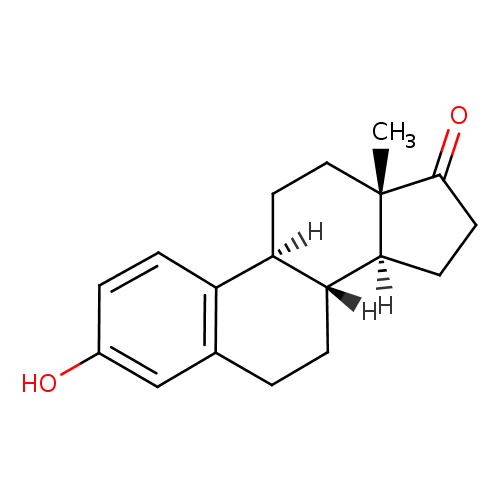|
Record Information |
|---|
| Version |
1.0 |
|---|
| Update Date |
1/22/2018 11:54:54 AM |
|---|
|
Metabolite ID | PAMDB120524 |
|---|
|
Identification |
|---|
| Name: |
estrone |
|---|
| Description: | The main Estrogens estrogens in humans are estrone, 17β-estradiol and estriol, which differ in the number of hydroxyl groups (one for estrone, two for 17β-estradiol and three for estriol). 17β-estradiol is about 10 times as potent as estrone and about 80 times as potent as estriol in its estrogenic effect.
17β-estradiol is the predominant estrogen in non-pregenant women during their reproductive years in terms of serum levels. estrone Estrone is the predominant circulating estrogen in women during menopause and estriol is the predominant circulating estrogen during pregnancy. |
|---|
|
Structure |
|
|---|
| Synonyms: | - hydroxyestronesfolliculinestrovarin
- 3-hydroxyl-1,3,5(10)-estratien-17-oneestrolfollicular hormoneprogynon
|
|---|
|
Chemical Formula: |
C18H22O2 |
|---|
| Average Molecular Weight: |
270.371 |
|---|
| Monoisotopic Molecular
Weight: |
270.162 |
|---|
| InChI Key: |
DNXHEGUUPJUMQT-CBZIJGRNSA-N |
|---|
| InChI: | InChI=1S/C18H22O2/c1-18-9-8-14-13-5-3-12(19)10-11(13)2-4-15(14)16(18)6-7-17(18)20/h3,5,10,14-16,19H,2,4,6-9H2,1H3/t14-,15-,16+,18+/m1/s1 |
|---|
| CAS
number: |
53-16-7 |
|---|
| IUPAC Name: | (1S,10R,11S,15S)-5-hydroxy-15-methyltetracyclo[8.7.0.0?,??0??,???heptadeca-2(7),3,5-trien-14-one |
|---|
|
Traditional IUPAC Name: |
estrone |
|---|
| SMILES: | CC12([CH](CCC(=O)1)[CH]4([CH](CC2)C3(C(=CC(O)=CC=3)CC4))) |
|---|
|
Chemical Taxonomy |
|---|
|
Taxonomy Description | This compound belongs to the class of organic compounds known as estrogens and derivatives. These are steroids with a structure containing a 3-hydroxylated estrane. |
|---|
|
Kingdom |
Organic compounds |
|---|
| Super Class | Lipids and lipid-like molecules |
|---|
|
Class |
Steroids and steroid derivatives |
|---|
| Sub Class | Estrane steroids |
|---|
|
Direct Parent |
Estrogens and derivatives |
|---|
| Alternative Parents |
|
|---|
| Substituents |
- Estrogen-skeleton
- 3-hydroxysteroid
- Hydroxysteroid
- 17-oxosteroid
- Oxosteroid
- Phenanthrene
- Tetralin
- 1-hydroxy-2-unsubstituted benzenoid
- Benzenoid
- Ketone
- Carbonyl group
- Organooxygen compound
- Hydrocarbon derivative
- Organic oxide
- Organic oxygen compound
- Aromatic homopolycyclic compound
|
|---|
| Molecular Framework |
Aromatic homopolycyclic compounds |
|---|
| External Descriptors |
|
|---|
|
Physical Properties |
|---|
| State: |
Solid |
|---|
| Charge: | 0 |
|---|
|
Melting point: |
258 - 260 °C |
|---|
| Experimental Properties: |
| Property | Value | Reference |
|---|
| Melting Point | 258 - 260 °C | Not Available | | Boiling Point | Not Available | Not Available | | Water Solubility | 0.03 mg/mL | Not Available | | LogP | 3.13 | HANSCH,C ET AL. (1995) |
|
|---|
| Predicted Properties |
|
|---|
|
Biological Properties |
|---|
| Cellular Locations: |
Not Available |
|---|
| Reactions: | |
|---|
|
Pathways: |
|
|---|
|
Spectra |
|---|
| Spectra: |
|
|---|
|
References |
|---|
| References: |
- Pfeiffer E, Graf E, Gerstner S, Metzler M: Stimulation of estradiol glucuronidation: a protective mechanism against estradiol-mediated carcinogenesis? Mol Nutr Food Res. 2006 Apr;50(4-5):385-9. [16598814 ]
- Czernik PJ, Little JM, Barone GW, Raufman JP, Radominska-Pandya A: Glucuronidation of estrogens and retinoic acid and expression of UDP-glucuronosyltransferase 2B7 in human intestinal mucosa. Drug Metab Dispos. 2000 Oct;28(10):1210-6. [10997942 ]
- Kuhl H, Wiegratz I: Can 19-nortestosterone derivatives be aromatized in the liver of adult humans? Are there clinical implications? Climacteric. 2007 Aug;10(4):344-53. [17653961 ]
- Parker WH, Broder MS, Liu Z, Shoupe D, Farquhar C, Berek JS: Ovarian conservation at the time of hysterectomy for benign disease. Clin Obstet Gynecol. 2007 Jun;50(2):354-61. [17513923 ]
- Stanway SJ, Delavault P, Purohit A, Woo LW, Thurieau C, Potter BV, Reed MJ: Steroid sulfatase: a new target for the endocrine therapy of breast cancer. Oncologist. 2007 Apr;12(4):370-4. [17470679 ]
- Ito K: Hormone replacement therapy and cancers: the biological roles of estrogen and progestin in tumorigenesis are different between the endometrium and breast. Tohoku J Exp Med. 2007 May;212(1):1-12. [17464097 ]
|
|---|
| Synthesis Reference: |
Kocovsky, Paved; Baines, Richard S. Synthesis of estrone via a thallium(III)-mediated fragmentation of a 19-hydroxyandrost-5-ene precursor. Tetrahedron Letters (1993), 34(38), 6139-40. |
|---|
| Material Safety Data Sheet (MSDS) |
Download (PDF) |
|---|
|
Links |
|---|
| External Links: |
|
|---|


